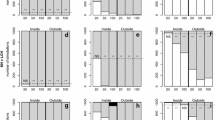Summary
One well-known solution to the iterated Prisoner's Dilemma is the TIT FOR TAT strategy. This strategy has three “characteristics” associated with it. TIT FOR TAT is nice (cooperates on the first move of a game), retaliatory (plays defect against an individual that defected on the prior move), and forgiving (cooperates with an individual which has defected in the past but cooperates in the present). Predator inspection behavior in guppies (Poecilia reticulata) was examined in order to determine whether guppies displayed these three characteristics. Results indicate that while it can be quite difficult to translate the abstract concepts of niceness, retaliation, and forgiveness into measurable behaviors, the data support the hypothesis that guppies display the three characteristics associated with the TIT FOR TAT strategy.
The “selfish herd” and “dilution effect” are discussed as possible alternative explanations for the observed behavior. These hypotheses alone were insufficient to explain the results.
Similar content being viewed by others
References
Axelrod R (1984) The evolution of cooperation. Basic Books, New York
Axelrod R, Hamilton WD (1981) The evolution of cooperation. Science 211:1390–1396
Boyd R (1988) Is the repeated Prisoner's Dilemma a good model of Reciprocal Altruism? Ethel Sociobiol 9:211–222
Boyd R (1989) Mistakes allow evolutionary stability in the repeated Prisoner's Dilemma game. J Theor Biol 136:47–56
Boyd R, Lorberbaum S (1987) No pure strategy is evolutionarily stable in the repeated Prisoner's Dilemma. Nature 327:58–59
Dominey W (1983) Mobbing in colonially nesting fish, especially the bluegill. Copeia 4:1086–1088
Dugatkin LA (1988) Do guppies play TIT FOR TAT during predator inspection visits? Behav Ecol Sociobiol 25:395–399
Dugatkin LA (1991) Predator inspection, TIT FOR TAT and shoaling: a comment on Masters and Waite. Anim Behav 41:898–900
Dugatkin LA, Alfieri M (1991a) Guppies and the TIT FOR TAT strategy: preference based on past interaction. Behav Ecol Sociobiol 28:243–246
Dugatkin LA, Alfieri M (1991b) TIT FOR TAT in guppies: the relative nature of cooperation and defection during predator inspection. Evol Ecol (in press)
Dugatkin LA, Godin JG (1992) Predator inspection, shoaling and foraging under predation hazard in the Trinidadian guppy (Poecilia reticulate): a field study. Env Biol Fish (in press)
Dugatkin LA (1992) Risk of death as a function of predator inspection in the guppy. Behav Ecol (in press)
Fraser D, Gilliam J (1987) Feeding under predation hazard: response of the guppy and Hart's rivulus from sites with contrasting predation hazard. Behav Ecol Sociobiol 21:203–209
George C (1960) Behavioral interactions in the pickerel and the mosquitofish. Ph D Thesis, Harvard University
Hamilton WD (1971) Geometry for the selfish herd. J Theor Biol 31:295–311
Helfman G, Meyer J, McFarland W (1982) The ontogeny of twilight migration patterns in grunts. Anim Behav 30:317–326
Lazarus J, Metcalfe N (1990) TIT FOR TAT cooperation in sticklebacks: a critique of Milinski. Anim Behav 39:987–989
Magurran AE (1990) The inheritance and development of minnow antipredator behaviour. Anim Behav 39:834–842
Magurran AE, Girling S (1986) Predator recognition and response habituation in shoaling minnows. Anim Behav 34:510–518
Magurran AE, Higgam A (1988) Information transfer across fish shoals under predator threat. Ethology 78:153–158
Magurran AE, Pitcher TJ (1987) Provenance, shoal size and the sociobiology of predator evasion in minnow shoals. Proc R Soc Lond [Biol] 229:439–465
Magurran AE, Seghers B (1990) Population differences in predator recognition and attack cone avoidance in the guppy. Anim Behav 40:443–453
Masters M, Waite T (1990) Tit-for-tat during predator inspection, or shoaling? Anim Behav 39:603–605
Maynard Smith J (1982) Evolution and the theory of games. Cambridge University Press, Cambridge
Milinski M (1977a) Do all members of a swarm suffer the same predation? Z Tierpsychol 45:373–378
Milinski M (1977b) Experiments on the selection by predators against the spatial oddity of their prey. Z Tierpsychol 43:311–325
Milinski M (1987) TIT FOR TAT and the evolution of cooperation in sticklebacks. Nature 325:433–435
Milinski M (1990) No alternative to TIT FOR TAT in sticklebacks. Anim Behav 39:989–991
Milinski M, Kulling D, Kettler R (1990a) Tit for Tat: sticklebacks “trusting” a cooperating partner. Behav Ecol 1:7–11
Milinski M, Pfluger D, Kulling D, Kettler R (1990b) Do sticklebacks cooperate repeatedly in reciprocal pairs? Behav Ecol Sociobiol 27:17–21
Motta P (1983) Response by potential prey to coral reef predators. Anim Behav 31:1257–1259
Neill S, Cullen J (1974) Experiments in whether schooling by their prey affects the hunting behaviour of crephalopods and fish predators. J Zool (Lond) 172:549–569
Noe R (1990) A veto game played by baboons: a challenge to the use of the Prisoner's Dilemma as a paradigm for reciprocity and cooperation. Anim Behav 39:78–91
Pitcher T, Green D, Magurran AE (1986) Dicing with death: predator inspection behavior. J Fish Biol 28:1439–1448
Seghers B (1973) An analysis of geographic variation in the antipredator adaptations in the guppy (Poecilia reticulate). Ph D Thesis, University of British Columbia
Author information
Authors and Affiliations
Rights and permissions
About this article
Cite this article
Dugatkin, L.A. Dynamics of the TIT FOR TAT strategy during predator inspection in the guppy (Poecilia reticulata). Behav Ecol Sociobiol 29, 127–132 (1991). https://doi.org/10.1007/BF00166487
Received:
Accepted:
Issue Date:
DOI: https://doi.org/10.1007/BF00166487




